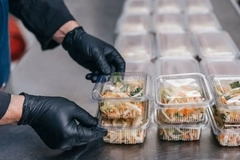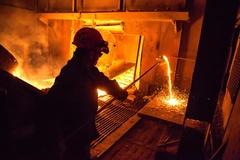Berry inspires Conagra cocoa carbon savings with cube container switch

17 Sep 2020 --- Conagra’s Swiss Miss Hot Cocoa line has shifted from cylinder to cube containers. The new packaging reduces its carbon footprint by 98 metric tons each year due to less energy required to manufacture and transport the material.
Created in partnership with Berry Global’s Blue Clover Studios, the new light blue container is made of recyclable plastic with a wraparound in-mold label. The space-efficient, stackable containers bring “more canisters into the facility on fewer pallets and trucks,” a Conagra spokesperson tells PackagingInsights.
According to a Berry Global analysis, the cubes reduce the carbon footprint associated with manufacturing and transporting the hot cocoa by 15 percent.
The new Swiss Miss containers feature an easy-grip side that is functional and stands out on shelf.The new package design will initially be used for Conagra Brands’ 38-oz. size Swiss Miss Milk Chocolate Hot Cocoa Mix.
Modernizing cocoa containers
Traditionally, cylinder canisters are the conventional choice for moisture-sensitive products, such as powders, coffee and nuts, the Conagra spokesperson notes. In a recent example, Brazilian superfoods brand Tubites launched a healthy snacking line in vibrant cylindrical packaging.
The new Swiss Miss container is part of Conagra’s strategy to make 100 percent of its current plastic packaging renewable, recyclable or compostable by 2025. “We look forward to sharing more about our sustainable packaging efforts in our 2020 corporate citizenship report, which will be published in the coming months,” notes the spokesperson.
The container also arrives with an easy-grip function. “The old round canister was difficult to hold and scoop. So when we looked at modernizing the package, we looked for a solution that was operationally functional and easier for consumers to use.”
No longer cutting corners
Rethinking packaging shape is a way of maximizing transportation space and reducing carbon footprints. This trend is known as “rightshaping,” which involves drawing on consumer insights to slightly adjust packages to be more attractive to customers.
Last year, Tetra Pak took one of its classic carton packs and redesigned its dimensions to launch the Tetra Classic Aseptic 65ml Cube packaging, touted as an efficient packaging solution for dairy, juice and liquid food.
Meanwhile, flavor giant Symrise aims to reduce its carbon footprint by rightsizing the packaging used throughout its supply chain. The company now uses large barrels instead of multiple small canisters “wherever possible.” Such alternatives require less transportation space and can reduce the need for additional packaging materials, which in turn lowers CO2 emissions.
By Anni Schleicher











